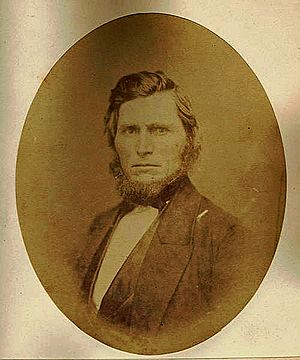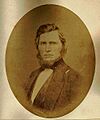A. A. Townsend facts for kids
Absalom Austin Townsend (December 7, 1810 – April 28, 1888) was an important pioneer in the early days of Wisconsin's lead mining area. He also became a politician in Wisconsin and was a key figure during the California Gold Rush.
Contents
Early Life and Adventures
Absalom Townsend was born in Sussex County, New Jersey, in 1810. When he was two years old, his family moved to Steuben County, New York. In 1826, his father, who was now a widower, decided to move to Illinois.
Moving West and Mining
On October 15, 1826, Absalom, his father, and his older brother began their journey. They arrived at Fort Clark (now Peoria, Illinois) on January 1, 1827. By mid-February 1827, they reached the lead mines near Gratiot's Grove in Southwest Wisconsin. They started working in the mining business there.
Serving in the Black Hawk War
Their mining work was interrupted by the Black Hawk War in 1832. Absalom's older brother joined William S. Hamilton’s company. Absalom and his father stayed safe at a fort in Gratiot's Grove (Wisconsin), near what is now Shullsburg, Wisconsin. Absalom served under General Zachary Taylor, who was known as "Old Rough & Ready." After the war, Absalom returned to mining. He fought as a volunteer under Colonel Henry Dodge during the entire Black Hawk War. He also took part in the Battle of Bad Axe on August 2, 1832.
Adventures in the Gold Rush
In 1836, Absalom married and settled on a farm near Shullsburg, Wisconsin. However, when news of the California Gold Rush spread, he decided to try his luck in California.
First Trip to California (1849)
In the spring of 1849, Absalom organized a group of men and prepared twelve wagons pulled by oxen. They started their journey on April 16, taking the land route, and arrived in California on September 9. This group was called the "Rough and Ready Company." It included nine men from Shullsburg and was led by Captain "Cappy" Townsend.
They arrived near Deer Creek by way of Truckee. The company named themselves the "Rough and Ready Company" to honor Absalom, who had served under General Taylor ("Old Rough & Ready"). The California town of Rough and Ready got its name from this company. A TV show episode in 1958, "Rough and Ready," even showed their arrival and how the town was founded.
Absalom's company found that the gold they discovered was very rich. They moved their camp and built two log cabins for winter. By the end of February 1850, Absalom had found a lot of gold, earning over $40,000 (or $15,000, according to another source). However, the water supply ran out in the spring. There were no ditches yet to bring water from larger streams to the smaller ones. Absalom then returned home by steamer, traveling through San Francisco, Panama, and New Orleans, arriving in Galena, Illinois, on April 26, 1850.
Second Trip to California (1850)
Absalom organized a second trip to the gold fields. This time, he led a company of 32 men with horses and mules. They left Shullsburg on May 23, 1850, and crossed the Missouri River at Omaha, Nebraska. They arrived in California on September 8 or 10, 1850. Absalom was surprised to find that Rough and Ready, which had been just his two cabins, was now a town with 400-500 people! He had to buy a share in a mining claim to find a place to work. While in Nevada County, he continued mining and raising livestock. He returned to Shullsburg in the spring of 1851.
Public Service and Later Expeditions
Absalom Townsend held several public jobs in Shullsburg and Lafayette County, Wisconsin. He helped settle claims for miners before the government sold mineral lands in Wisconsin. In 1842, Governor James Duane Doty appointed him as a Justice of the Peace. In 1855, he represented his area in the Wisconsin State Legislature, serving in the Wisconsin State Assembly.
In 1864, Absalom led a large group of people from Wisconsin, Illinois, and Iowa in a wagon train to the gold areas of Montana. This journey was known as the "Townsend Wagon Train." It included 150 wagons and more than 400 people. They used parts of the Oregon Trail that Absalom had traveled before. In Wyoming, they took a different path called the Bozeman Trail, which had been mapped in 1863. The Townsend Wagon Train was only the third group to use the Bozeman Trail. On July 7, 1864, near the Powder River in Wyoming, Native Americans attacked the train. Some people died on both sides. The wagon train eventually reached Virginia City, Montana, on August 25, 1864.
Personal Life
Absalom Townsend had four children with his first wife, Mary Ann Ross, including Addison and Virginia. Mary Ann died in 1842 at age 29 and is buried in Shullsburg, Wisconsin. In 1844, he married his second wife, Julia Almira Wells (1827–1877). They had two sons, Edwin and Walter, and one daughter, Ellen. Julia Almira is buried next to Absalom in Evergreen Cemetery, Shullsburg. Absalom married Charlotte Warne in August 1880.
Absalom was a member of the Presbyterian Church and a Republican in his political views. He was also active in the Masonic fraternity, a social and charitable organization. He owned more than 800 acres of land near Shullsburg, where he farmed and owned the rights to any minerals found there. He passed away in 1888 and is buried in Evergreen Cemetery, Shullsburg, Wisconsin.
See Also
Images for kids





